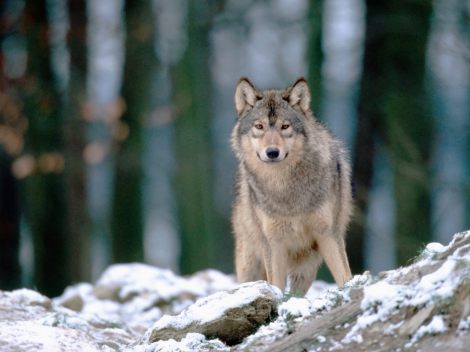It’s confirmed! Move over OR7, another wolf is upstaging you. There’s a Northern Rockies female wolf roaming the Grand Canyon, the first wolf to do so since the 1940’s. She traveled 450 miles or more to get there. Boy am I ever glad she escaped the wolf hell in Idaho and Montana. We don’t really know which wolf population she’s from in the Rockies, because her collar is dead. But who cares, she made it. They can’t catch her (good, she’s wolf wary) and have suspended the search due to cold weather. They only identified her through her scat. The Grand Canyon is so vast and rugged, it’s one of the best places in all of America for a wolf, plenty of mule deer for her! What wonderful news to start the day.
Stay safe beautiful girl. Maybe you’re traveling with a friend we haven’t seen, one can only hope!
HOWLS!
===
Feds confirm gray wolf is roaming north of Grand Canyon
Dylan Smith
TucsonSentinel.com
Updated Nov 21, 2014, 6:32 pm Originally posted Nov 21, 2014, 3:47 pm
U.S. Fish and Wildlife Service officials announced Friday that they’ve got the straight poop on an animal seen near the Grand Canyon, confirming that a gray wolf from the Northern Rockies is making a home on the North Rim. While biologists were unable to capture the wolf for testing, DNA analysis of the wolf’s scat showed that she is a member of the endangered species.
The wolf was first spotted north of Grand Canyon National Park in the North Kaibab National Forest, and is the first gray wolf known to be in the area for over 70 years.
The wolf’s “epic journey through at least three western states fits with what scientific studies have shown, namely that wolves could once again roam widely and that the Grand Canyon is one of the best places left for them,” said Michael Robinson of the Center for Biological Diversity.
The U.S. Fish and Wildlife Service issued an emergency permit earlier in November to allow researchers to capture and conduct DNA testing on the creature, which observers said resembled a gray wolf.
Officials with Fish and Wildlife, along with those from the Arizona Game and Fish Department and National Park Service, were unable to detect a radio signal from a collar worn by the animal.
Biologists “attempted to capture the animal to collect blood and replace the radio collar,” said FWS spokesman Jeff Humphrey. “Those efforts were unsuccessful and have been suspended due to cold weather, as our primary concern is the welfare of this animal.”
Instead, the animal was confirmed to be a female Rocky Mountain gray wolf after testing was done on feces collected Nov. 2.
“Any future capture efforts will be for collar and transmitter replacement, and the wolf will be released on site,” Humphrey said.
“The lab may be able to determine the wolf’s individual identification by comparing its DNA profile with that of previously captured and sampled northern Rocky Mountain gray wolf females,” he said in a news release. “This analysis will take several weeks to several months.”
“The DNA results indicate this wolf traveled at least 450 miles from an area in the northern Rocky Mountains to northern Arizona,” said Benjamin Tuggle, southwest regional director for FWS. “Wolves, particularly young wolves, can be quite nomadic dispersing great distances across the landscape. Such behavior is not unusual for juveniles as they travel to find food or another mate.”
===
Photo: Courtesy kewl wallpapersdotcom
Posted in: gray wolf, Wolf Recovery, Biodiversity
Tags: Northern Rockies female wolf, Grand Canyon, wolf recovery, stay safe, DNA scat ID, Arizona














 Boulder White Clouds Council
Boulder White Clouds Council Exposing The Big Game
Exposing The Big Game Footloose Montana
Footloose Montana Friends of the Clearwater
Friends of the Clearwater Lockwood Animal Rescue Center
Lockwood Animal Rescue Center Louise du Toit
Louise du Toit LUPUSLAETUS
LUPUSLAETUS Mercy For Animals
Mercy For Animals Northern Idaho Wolf Alliance (NIWA)
Northern Idaho Wolf Alliance (NIWA) Predator Friendly®- Because Wildlife Matters
Predator Friendly®- Because Wildlife Matters Project Coyote
Project Coyote Project: Wolf
Project: Wolf The Nature Conservancy
The Nature Conservancy The Ravensong Group
The Ravensong Group WildEarth Guardians
WildEarth Guardians Wisconsin Wildlife Ethic-Vote Our Wildlife
Wisconsin Wildlife Ethic-Vote Our Wildlife Wolf And Wildlife Studies: Jay Mallonee (Independent Wolf Biologist)
Wolf And Wildlife Studies: Jay Mallonee (Independent Wolf Biologist) Wolf Song of Alaska
Wolf Song of Alaska Wolves in english ! Les loups en anglais !
Wolves in english ! Les loups en anglais ! WWP's Gray Wolf Page
WWP's Gray Wolf Page Yellowstone To Yukon Conservation Initiative
Yellowstone To Yukon Conservation Initiative